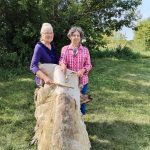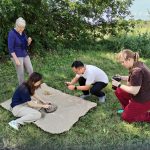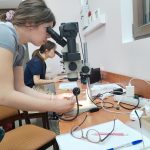Experimental and traceological (microwear) expedition in Bolgar
Since August 12, 2025, an expedition dedicated to experimental traceology has its work in Bolgar, on the basis of the International center for archaeological research. This is a scientific method that allows us to determine how ancient tools were used, based on the traces left on them by time and use. The expedition is organized by the Institute for the History of Material Culture of the Russian Academy of Sciences and the Institute of Archaeology named after A.Kh. Khalikov of the Tatarstan Academy of Sciences. The research is led by Natalia Nikolaevna Skakun and Madina Shakirovna Galimova.
Scientists, graduate students and students from various cities of Russia: St. Petersburg, Kazan, Samara, Yekaterinburg, Chelyabinsk, Izhevsk, have joined the expedition. A professor and a graduate student from Sun Yat-sen University (Guangzhou, China) also taking part in the work.
The objective of the experiments is to create “standards”, that are samples of microwear needed for the accurate identification of ancient tools. Experiments are conducted according to strict procedures developed in long-term expeditions of the use-wear laboratory at the Institute for the History of Material Culture RAS. The research involves careful preparation, precise formulation of objectives, reconstruction of as close to ancient conditions as possible, repeated experimentation to get reliable results, statistical analysis of the results and detailed documentation: description, tool drawing, macro- and microphotographs.
In 2025, the expedition members are conducting a number of additional experiments. For instance, they will trat deer hides with tools made of horse and cow jawbanes – these tools are frequently found at Chalcolithic-Bronze Age sites. The results obtained will be compared with the operation of flint inserted tools. Additionally, it is also planned to grind ore, make tools and household items from pottery shards, and construct an experimental replica of the unique Dalverzin-type stone sickle (Ferghana valley, Uzbekistan) in order to thoroughly study its manufacturing process. Furthermore, the researchers will continue studying the wear patterns on flint tools used for cereals, grass and reed cutting, for removing mezdra (inner side of hide) from narrow hide areas, as well as for processing bone and horn processing (sawing, scrapping, cutting).
These data will assist scientists in reconstructing production processes from different historical periods and uncovering the skill secrets of ancient craftsmen.




